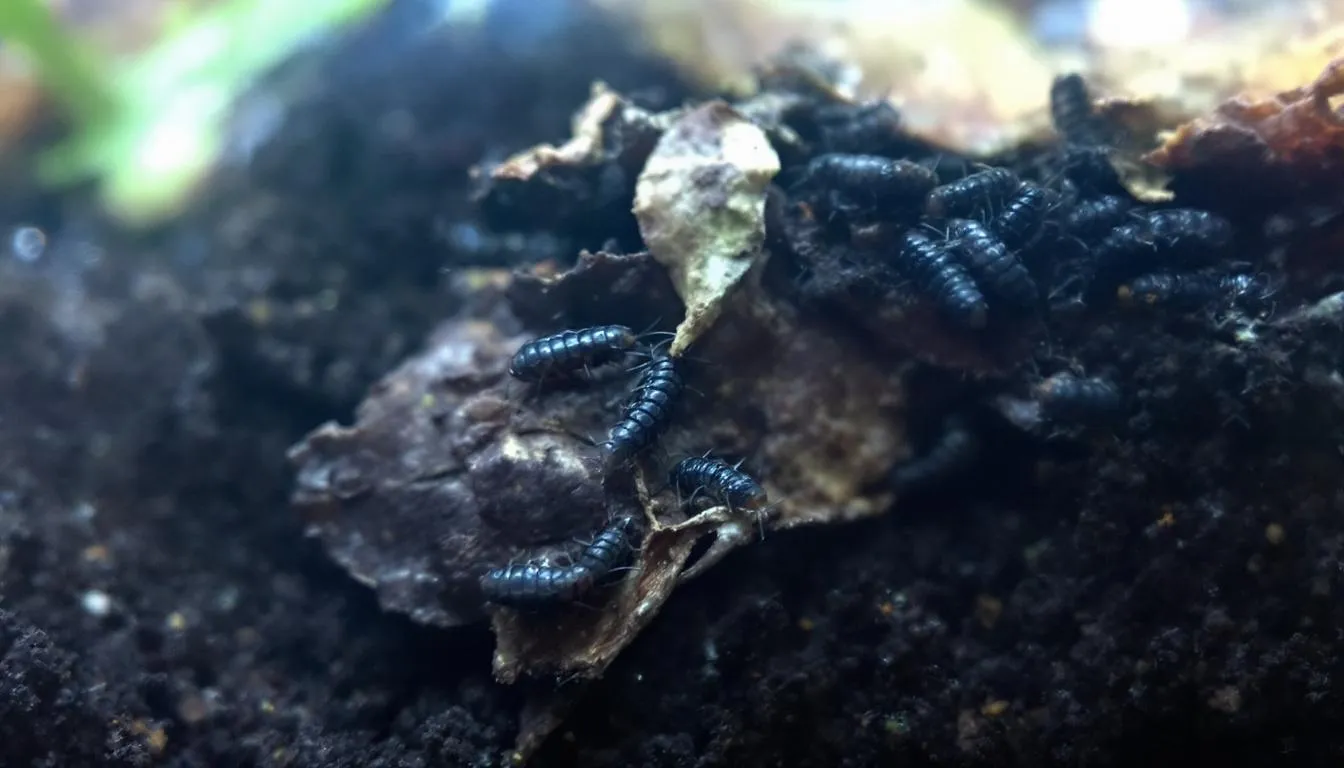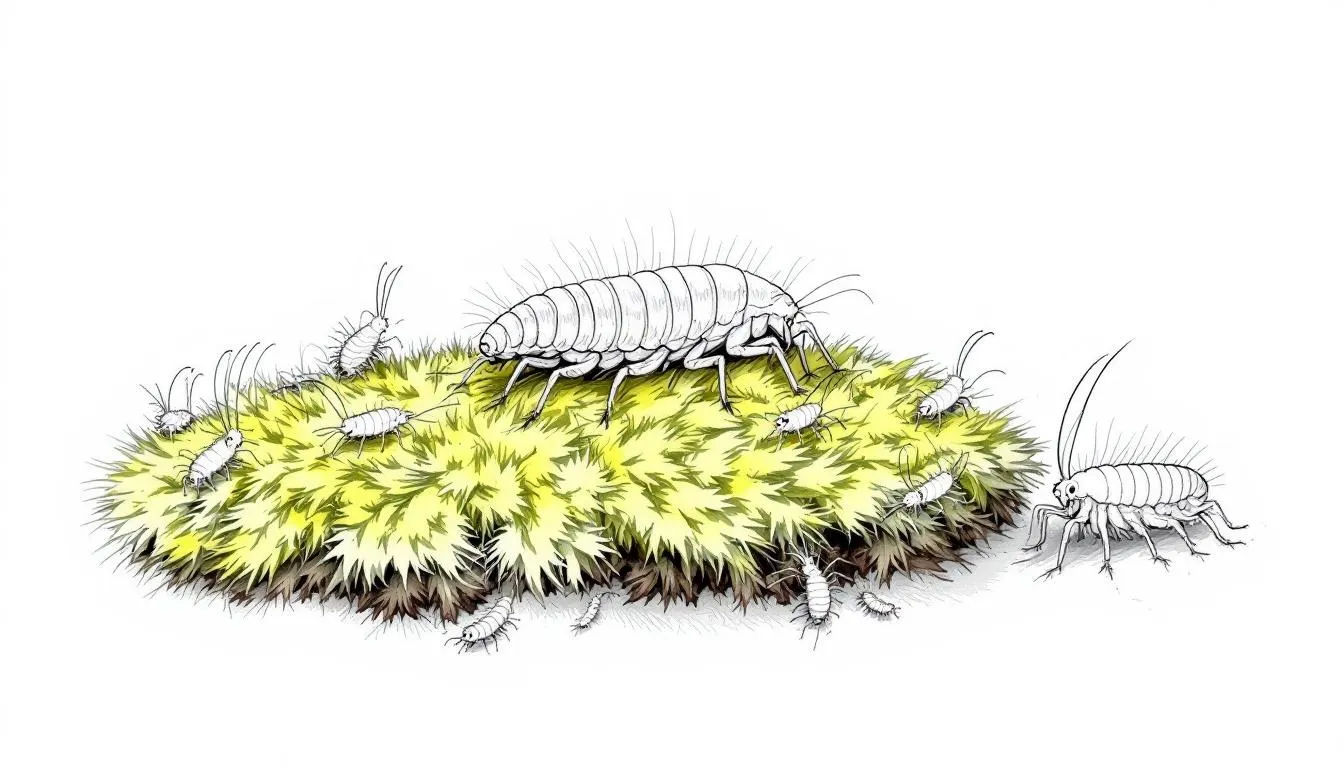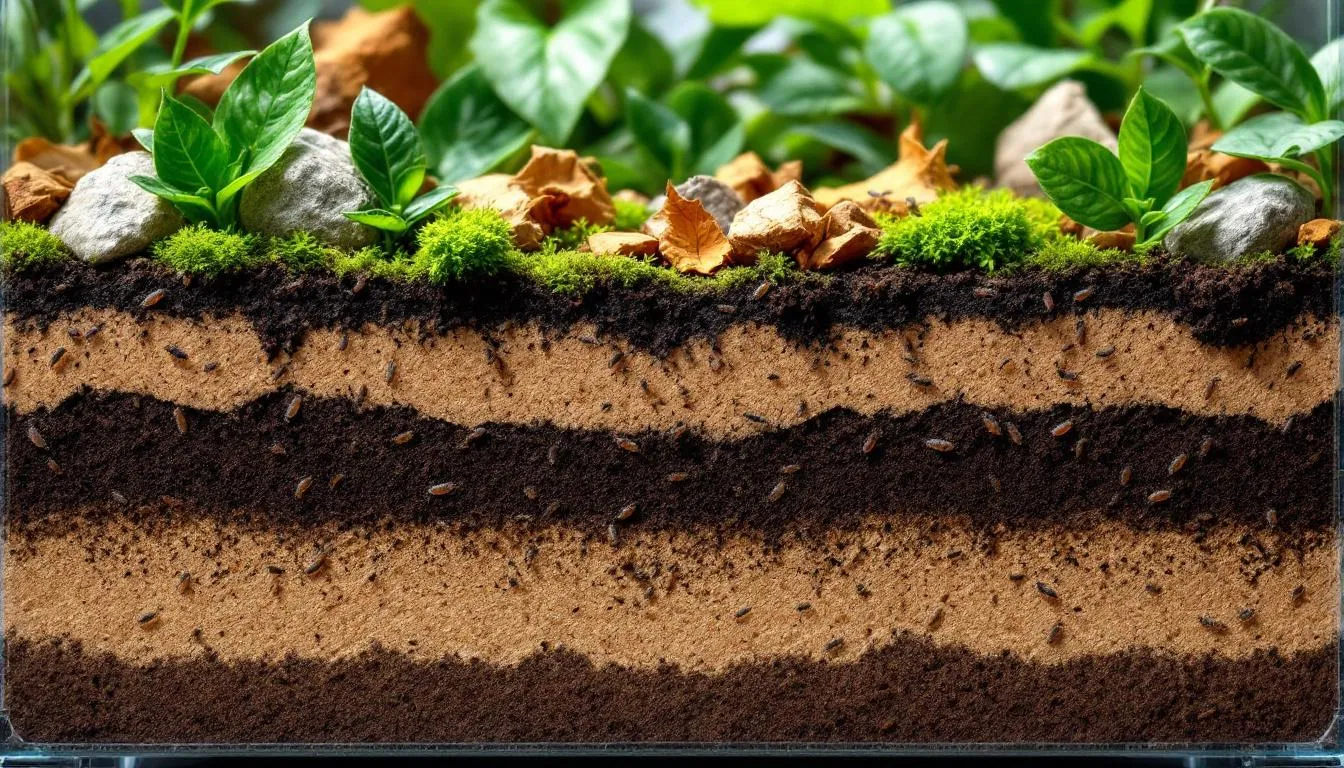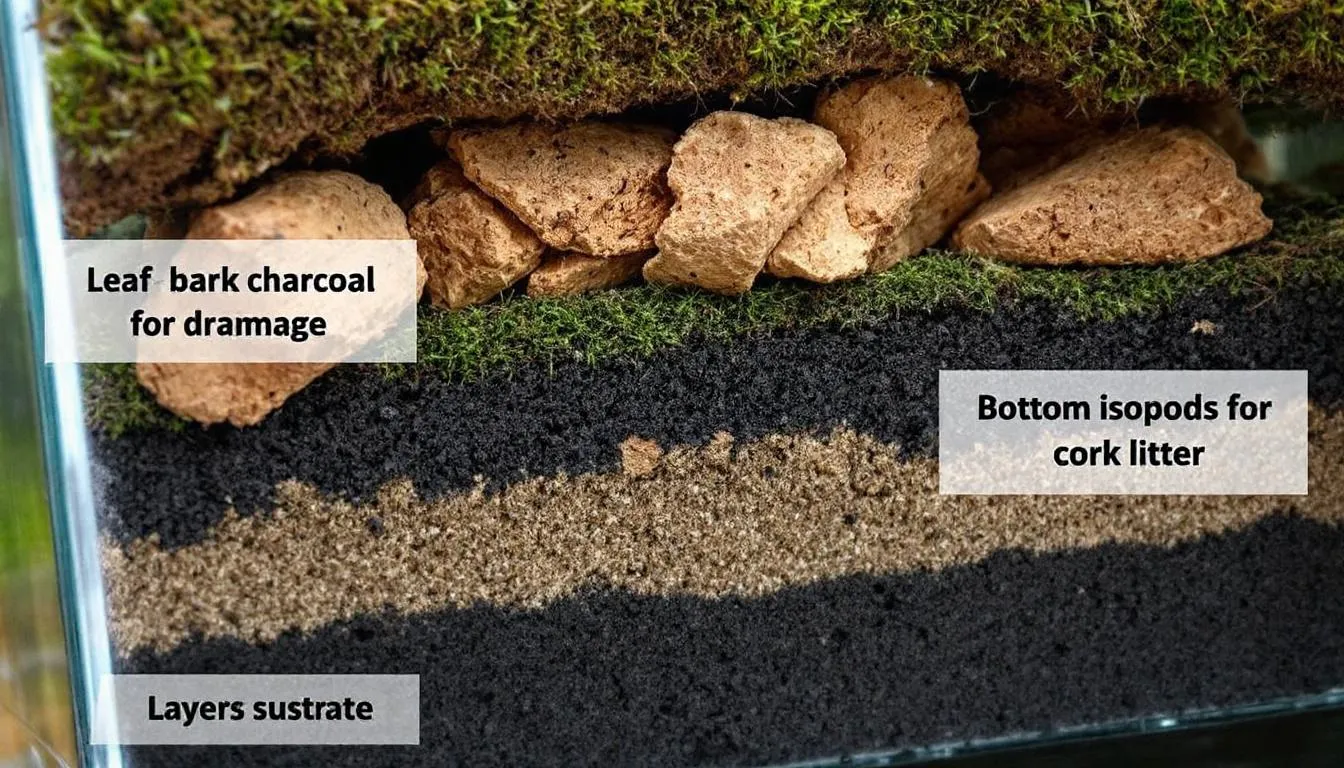Will Isopods Eat Springtails? The Truth About These Bioactive Cleanup Crew Members
Introduction to Bioactive Cleanup Crews
A thriving terrarium relies on more than just plants and décor—it needs a hardworking bioactive cleanup crew to keep everything in balance. Isopods and springtails are the backbone of these micro-ecosystems, working tirelessly behind the scenes to break down decaying organic material and keep the environment healthy. By consuming leaf litter, old plant matter, and other organic debris, these tiny creatures help prevent mold outbreaks and keep the soil fresh and fertile.
Tropical white springtails and dwarf white isopods are especially popular choices for bioactive setups. When introduced together, isopods and springtails form a dynamic team: isopods tackle larger pieces of decaying matter, while springtails focus on microscopic mold and fungi. This partnership not only keeps the terrarium clean but also helps fertilize the soil, providing essential nutrients for plants to thrive. Whether you’re setting up a new terrarium or looking to improve an existing one, including both isopods and springtails ensures a balanced, self-sustaining ecosystem that mimics the natural processes found in the wild.
Key Takeaways
-
Isopods do not typically eat springtails as they prefer different food sources and occupy slightly different ecological niches in terrarium environments
-
Both species function as compatible cleanup crew members that work synergistically rather than competitively in bioactive setups
-
Springtail species unlike isopods focus primarily on mold, fungi, and microscopic organic matter, while isopods handle larger decaying material
-
Proper environmental conditions including humid conditions and adequate organic matter ensure both populations thrive without predation concerns
-
These detritivorous species complement each other perfectly, with isopods aerating soil through tunneling while springtails control fungal growth in tight spaces
The terrarium community has long debated whether isopods and springtails can coexist peacefully in bioactive enclosures. Many keepers worry that introducing both species might lead to one consuming the other, particularly whether larger isopod species might prey on delicate springtails. This concern often prevents hobbyists from creating the diverse cleanup crews that make bioactive setups so successful.
The truth is far more encouraging than these fears suggest. Scientific observation and decades of practical experience from the terrarium tribe reveal that isopods and springtails form one of nature’s most effective partnerships for maintaining healthy enclosures. Understanding their distinct dietary preferences and complementary functions will help you create thriving bioactive systems where both species flourish together.

Understanding Isopod and Springtail Diets
Isopods are omnivorous detritivores with a diet centered on decaying organic material. In their natural habitat, these crustaceans devour fallen leaf litter, rotting wood, and decomposing plants with remarkable efficiency. Their feeding habits extend beyond plant matter to include fungi, mold, and occasional protein sources when available. The diet of isopods in terrarium environments mirrors these natural preferences, making them excellent processors of larger organic debris. Some isopod and springtail species have also been selectively bred for traits like visual diversity or increased reproductive rates, enhancing their appeal and suitability for terrarium use.
Dwarf white isopods and other popular terrarium species eagerly consume fish food, repashy bug burger, and other supplementary foods provided by keepers. They also serve as nature’s recyclers, breaking down frass from primary animals and turning cork bark pieces into soil over time. This diverse appetite makes isopods love environments rich in decaying matter where they can fulfill their role as primary decomposers.
Springtails occupy a different dietary niche despite sharing some overlap with isopod preferences. These tiny arthropods primarily feed on fungi, mold, fungus, spores, bacteria, and the smallest particles of organic detritus. Tropical white springtails excel at consuming the film of microorganisms that develops on moist surfaces, effectively keeping terrarium clean by preventing problematic mold growth. The white ones are the most reliable and popular springtail species for bioactive setups, preferred for their natural look and proven performance. Their small size allows them to access tight spaces between substrate particles where larger cleanup crew members cannot reach.
The dietary differences between these species create natural niche partitioning rather than direct competition. While isopods tackle substantial pieces of decaying plants and larger organic matter, springtails focus on microscopic food sources that would be too small for isopods to efficiently process. This complementary feeding strategy means both species can thrive in the same environment without competing for resources.
Do Isopods Actually Eat Springtails?
The direct answer to whether isopods eat springtails is a resounding no under normal terrarium conditions. Extensive observation by both researchers and experienced keepers consistently shows that healthy isopods do not prey upon living springtails as a food source. The size difference alone makes this interaction impractical, as most springtails are agile enough to avoid slow-moving isopods even in confined spaces.
The terrarium community has long debated the coexistence of these species, with many keepers sharing their experiences and questions in online forum posts about isopods and springtails.
Several factors explain why predation rarely occurs between these species. First, isopods lack the hunting adaptations necessary for catching live prey. Their mouthparts and digestive systems are optimized for processing decaying matter rather than capturing and consuming mobile organisms. Additionally, springtails possess remarkable escape abilities, using their specialized furcula to spring away from potential threats with impressive speed.
Terrarium environments are often prone to mold growth due to their warmth and humidity, but isopods and springtails help control this by consuming mold and decomposing organic matter.
Rare instances where isopods might consume springtails typically involve already dying or dead specimens rather than active predation. In severely underfed cultures where adequate organic matter is scarce, desperate isopods might scavenge any available protein source, including deceased springtails. However, these situations represent environmental stress rather than normal behavior and can be easily prevented through proper feeding protocols.
The scientific literature supports these observations, with studies showing minimal dietary overlap between isopods and springtails in natural ecosystems. Field research consistently documents these species coexisting without significant predation pressure, reinforcing the safety of co-culturing them in terrarium environments. This evidence gives keepers confidence that introducing both species creates beneficial relationships rather than predatory ones.

Why Isopods and Springtails Make Perfect Terrarium Partners
The partnership between isopods and springtails represents one of nature’s most efficient decomposition systems. Isopods excel at breaking down larger organic materials like fallen leaves, small piece of fruit, and substantial plant debris. Their powerful mandibles can process tough materials that would remain intact for extended periods without their intervention. This mechanical breakdown creates smaller particles that become accessible to other decomposers in the system. Isopods can also serve as a healthy snack for reptiles or other terrarium inhabitants, providing a nutritious and natural food source within a balanced ecosystem.
Springtails complement this process by handling the finest organic particles and controlling fungal growth that might otherwise overwhelm terrarium environments. They consume mold spores before problematic fungi can establish, effectively preventing the white fuzzy growth that plagues poorly maintained enclosures. Their ability to navigate the smallest spaces means they can clean areas that larger species cannot access, creating comprehensive substrate maintenance. Including calcium-bearing materials, such as calcium-bearing clay, in the substrate is important for supporting healthy springtail colonies and thriving bioactive terrarium ecosystems.
The different microhabitat preferences of these species further enhance their compatibility. Isopods often occupy deeper substrate layers where they create extensive tunnel networks that improve soil aeration and drainage. Some isopod species are fine in drier conditions, while others require more humidity to thrive. Meanwhile, springtails concentrate in the uppermost moist zones where organic matter first begins decomposing and fungal activity is highest. This vertical stratification allows both species to maximize their ecological impact without direct interference.
Complementary Functions in Bioactive Systems
Isopods contribute to bioactive setups through their tunneling behavior, which creates essential air channels throughout the substrate. This soil soft aeration prevents anaerobic conditions that could lead to harmful bacterial growth or root rot in planted enclosures. Their movement also helps distribute moisture and nutrients throughout the substrate, creating more uniform growing conditions for plants.
The waste products from both species enrich terrarium substrates with essential nutrients. Isopod frass contains concentrated organic compounds that fertilize plants naturally, while springtail waste contributes to the microbial diversity necessary for healthy soil ecosystems. Together, they create a self-sustaining nutrient cycle that reduces the need for external fertilizers or frequent substrate replacement.
Springtails serve as living mold control, consuming fungal spores and organic films before they can develop into visible problems. This continuous cleaning action keeps surfaces clear and prevents the accumulation of harmful microorganisms. Their rapid reproduction allows populations to quickly expand when food sources increase, providing responsive biological control that adapts to changing conditions.

The Role of Dwarf White Isopods
Dwarf white isopods are a favorite among terrarium enthusiasts for good reason. Their small size makes them perfect for compact spaces, and their appetite for decaying organic material means they’re always busy breaking down leaf litter and softwood chunks. These isopods thrive in humid conditions, making them ideal for tropical terrariums where moisture levels are consistently high.
Beyond their role as decomposers, dwarf white isopods contribute to the overall health of the terrarium by aerating the soil as they tunnel and move about. This natural soil turnover helps roots breathe and promotes healthy plant growth. As they process decaying matter, they also release nutrients back into the substrate, acting as a natural fertilizer for your plants. The terrarium tribe often recommends dwarf white isopods for both beginners and experienced keepers, as they are easy to care for and help maintain a clean, balanced environment. Whether you’re working with a small desktop terrarium or a larger vivarium, these isopods are a reliable addition to any bioactive cleanup crew.
The Importance of Diversity in Terrarium Ecosystems
Creating a diverse terrarium ecosystem is key to long-term success and minimal maintenance. By incorporating a variety of isopod species, springtail species, and other beneficial microfauna, you ensure that every aspect of the environment is cared for. Different species specialize in breaking down various types of decaying matter, controlling mold, and maintaining soil health, so a mix of cleanup crew members leads to a more balanced and resilient ecosystem.
Diversity also helps prevent the overpopulation of any single species, which can disrupt the natural balance and lead to issues like resource competition or uneven waste breakdown. When you create a terrarium environment with a range of isopod species and springtail species, you’re mimicking the complexity of natural habitats, where many organisms work together to keep the ecosystem healthy. This approach not only keeps your terrarium looking its best but also reduces the need for frequent intervention, allowing you to enjoy a vibrant, self-sustaining environment with minimal effort.
Optimal Conditions for Both Species
Creating an environment where both isopods and springtails thrive requires careful attention to humidity, temperature, and substrate composition. Both species prefer humid conditions ranging from 70-90% relative humidity, making them ideal partners for tropical vivariums and other high-moisture enclosures. This shared preference for moist environments eliminates the need to create separate climate zones within terrarium setups.
Temperature requirements also align well between these species, with optimal ranges falling between 65-75°F for most commonly kept varieties. Dwarf white isopods and tropical white springtails both tolerate slight temperature fluctuations, making them forgiving choices for keepers still learning to regulate environmental conditions. Warm temperatures accelerate their metabolism and reproduction, leading to more active cleanup crews that process waste more efficiently.
Substrate selection plays a crucial role in supporting both species successfully. A mixture of organic components including leaf litter, cork bark pieces, and sphagnum moss provides the diverse microhabitats each species prefers. The substrate should include charcoal for pH control and various particle sizes to create the complex structure that supports their different living preferences.
Regular feeding supplements ensure both populations remain healthy and active. Offering small amounts of fish food, repashy bug burger, or even small piece of fruit provides additional nutrition beyond what natural decomposition supplies. These supplementary foods should be offered sparingly to prevent mold growth while ensuring adequate nutrition for sustained population growth.
Setting Up a Successful Isopod and Springtail Culture
Beginning with starter cultures of appropriate size ensures successful establishment of both species in new terrariums. A culture of 10-20 dwarf white isopods paired with a robust springtail culture provides sufficient genetic diversity and population size for sustainable breeding. These numbers allow for natural population fluctuations while maintaining viable breeding groups of both species.
The container should provide adequate space for both species to establish territories and breeding areas. A bioactive setup measuring at least 10 gallons offers sufficient room for population growth and environmental complexity. Larger enclosures naturally support more diverse microclimates and can house larger populations without overcrowding concerns.
Essential materials include a drainage layer of charcoal or gravel, diverse organic substrate, and hiding areas like cork bark pieces and dense vegetation. These components create the environmental complexity necessary for both species to find their preferred microhabitats. The substrate should be several inches deep to accommodate isopod tunneling while providing surface area for springtail activity.
Establishment typically takes 4-6 weeks for visible population growth, though both species begin contributing to cleanup functions immediately upon introduction. During this period, minimal disturbance allows populations to settle and begin reproducing. Observing both species during morning feeding times helps monitor establishment success and identify any environmental adjustments needed.

Best Species Combinations
Dwarf white isopods (Trichorhina tomentosa) paired with temperate white springtails represent the most reliable combination for beginning keepers. Both species tolerate a wide range of conditions and reproduce readily in captivity. Their small size makes them suitable for most terrarium applications without overwhelming smaller enclosures or bothering shy animals.
For tropical setups with consistently warm and humid conditions, larger isopod species like Porcellionides pruinosus can be paired with tropical springtail varieties. These combinations work well in dart frog enclosures and other humid vivariums where higher temperatures support more active populations. The larger species can process bigger pieces of organic matter while maintaining the same non-predatory relationship.
Temperate setups benefit from combinations of Armadillidium species with cold-tolerant springtail cultures. These pairings work well in environments with natural temperature fluctuations or seasonal cooling periods. Both groups can enter dormancy during cooler periods and resume activity when conditions improve.
Avoid mixing species with dramatically different environmental requirements, such as desert-adapted isopods with moisture-dependent springtail species. While these combinations won’t result in predation, the conflicting environmental needs make it difficult to maintain healthy populations of both species simultaneously.
Common Misconceptions and Troubleshooting
One persistent myth suggests that larger isopod species pose greater threats to springtail populations. In reality, size differences actually reduce predation likelihood since larger isopods are even less suited to catching agile springtails. Species like Trachelipus rathkii and other larger species maintain the same detritivorous feeding habits regardless of their size, focusing on plant matter and organic debris rather than live prey.
Population imbalances often create concern among new keepers who notice fluctuations in visible numbers of either species. These changes typically reflect natural population cycles, seasonal activity patterns, or responses to food availability rather than predation pressure. Healthy populations naturally regulate themselves based on available resources and environmental conditions.
Signs of struggling populations include reduced activity, smaller individuals, or visible stress behaviors like clustering in unusual locations. These symptoms usually indicate environmental problems such as incorrect humidity, temperature stress, or inadequate food rather than interspecies conflict. Addressing the underlying environmental causes typically resolves population issues more effectively than separating species.
When springtail populations appear to decline while isopods remain stable, the cause is almost always environmental rather than predatory. Springtails are more sensitive to humidity fluctuations and chemical changes, making them early indicators of environmental problems. Adjusting moisture levels and checking for harmful substances usually restores springtail numbers without requiring species separation.

The key to preventing population problems lies in maintaining stable environmental conditions and providing adequate food sources for both species. Regular monitoring helps identify issues before they become serious, while gradual environmental adjustments prevent shock that could affect sensitive populations. Remember that both species are resilient when their basic needs are met consistently.
Balancing population levels naturally occurs when environmental conditions remain stable and food sources are adequate. Overpopulation of either species typically self-regulates through reduced reproduction rates rather than increased mortality. Providing diverse hiding spaces and food sources helps maintain this natural balance without intervention.
Understanding the normal behavior patterns of both species helps distinguish between healthy activity and concerning changes. Isopods naturally become more active during feeding times and humid periods, while springtails show increased movement when organic matter becomes available. These patterns indicate healthy, responsive populations rather than stress behaviors.
FAQ
Can I keep isopods and springtails together in breeding cultures outside of terrariums?
Yes, isopods and springtails can be successfully cultured together in dedicated breeding containers. Use similar environmental conditions as terrarium setups with adequate humidity, organic substrate, and regular feeding. The non-predatory relationship remains the same in culture containers, and both species actually benefit from the improved substrate conditions created by their combined activities.
What should I do if my springtail population crashes while isopods continue thriving?
Springtail population crashes are typically caused by environmental factors rather than isopod predation. Check humidity levels first, as springtails are more sensitive to drying conditions. Examine the substrate for chemical contamination from soaps, pesticides, or inappropriate materials. Increase organic matter and reduce disturbance to allow populations to recover naturally.
Do different isopod species have varying likelihood of eating springtails?
No, dietary preferences remain consistent across isopod species regardless of size or origin. All commonly kept isopod species are detritivorous and lack the adaptations necessary for effective predation on springtails. Larger species like Trachelipus rathkii or Armadillidium species maintain the same feeding habits focused on decaying organic matter rather than live prey.
How long does it take to establish stable populations of both species in a new bioactive setup?
Establishment typically takes 6-8 weeks for both species to show visible population growth and begin reproducing successfully. Initial colonization occurs within the first week, but stable, self-sustaining populations require time to adapt to the specific environmental conditions and establish breeding groups. Monitor activity levels and provide supplemental feeding during this establishment period.
Will isopods and springtails compete for hiding spots in smaller enclosures?
Competition for space is minimal due to different microhabitat preferences. Isopods prefer deeper substrate areas and larger hiding spaces like under cork bark pieces, while springtails utilize surface areas and tiny crevices. Providing diverse hiding options including leaf litter, moss, and varied substrate depths accommodates both species even in smaller containers. The vertical stratification of their preferred zones reduces direct competition for the same spaces.







